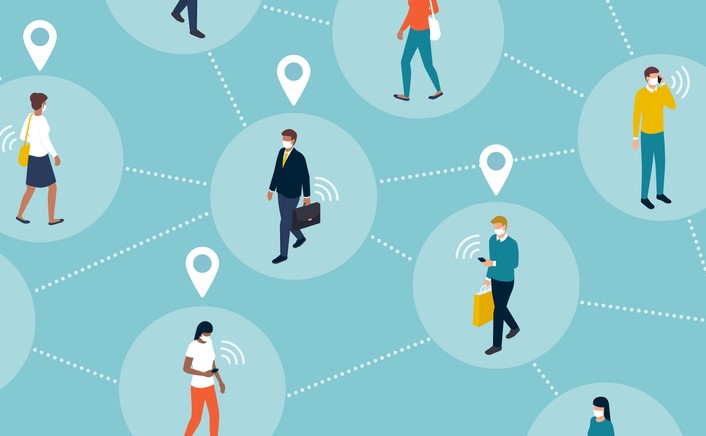As governments around the world continue to face the escalating crisis and come up with pandemic management plans, many are considering the benefits of digital surveillance networks.
With the advent of 5G networks and faster mobile speeds, digital surveillance can provide near real-time contact traceability to quickly identify and manage infections at the municipal or community level, predict the need for medical resources in order for it to be allocated where necessary, and measure compliance with local emergency guidelines and regulations.
The technique was used successfully in several countries. In South Korea, the government used smartphone location tracking, CCTV footage, and credit card transaction data to map transmission chains. They also released public notices and anonymized movement logs where individuals tested positive. Israel made it possible for mobile carriers to share location data of smartphones and track the history of COVID-positive patients.
Meanwhile, China's Alipay launched a platform that captures the history of smartphone locations at certain “checkpoints,” assigning color codes to identify citizens who may have the virus and sharing relevant information with local law enforcement authorities. Russia also followed suit with similar initiatives to track smartphone geolocation data.
CDC Director Robert Redfield emphasized the need to introduce vigorous contact tracing and highlighted government efforts to assess tech-savvy ways of making surveillance more proficient and successful. While the US plan for setting up digital surveillance systems is currently still in progress, scientists and technology firms are researching location tracking approaches that do not depend on direct and continuous geolocation data.
When giants unite
Google and Apple, two of the world 's biggest tech companies, recently announced a collaboration to jointly develop national contact tracing APIs. These APIs will use Bluetooth data transmitted between nearby devices to determine the proximity of these mobile devices without gathering the location data of any specific individual. Every device connected to the Internet has a unique IP address that identifies it. Many of us go to extreme lengths to hide our IP addresses.
However, with this technology, when enabled, individual phones will interchange anonymized verification beacons also known as "chirps" or "keys" that will change every few minutes to prevent any identifiers that could be linked back to a specific individual or their device. Devices will store this information locally for 14 days and log all encounters with independent users of the application.
Should users test COVID-positive, they may decide to opt-in to allow their anonymous interactions to be shared locally via the cloud to notify these contacts of their exposure. Apple and Google will implement these features directly into Android & iOS software in the near future to allow people to opt-in without the additional effort of downloading apps.
MIT was the first institute of learning to deploy Bluetooth-based contact tracing technology via its SafePaths app, followed by the Stanford COVID Watch application. An EU research group also recently identified and published their best software standards for Bluetooth-based tracing, which was termed Pan-European Privacy-Preserving Proximity Tracing. It seems as if some of the prevalent safety concerns regarding Bluetooth technology have been set aside for the time being as MIT entered the fray by introducing the PACT Protocol initiative in an effort to share their open-source, privacy-preserving protocol with key tech leaders, urging industry players to pick it up.
Looking at the pros and cons of digital contact tracing
New innovations in scanning and tracking applications, like this receipt scanner from Wave, are not limited to healthcare but can be found across other industries that include finance and banking. The new approach to digital contact tracing provides multiple significant advantages over the global use of conventional contact tracing and alternative methods of digital surveillance.
Digital tracing offers a scalable approach when compared to traditional contact tracing, which is generally based on memories of patients' recent exposure to others. As the coronavirus continues to spread throughout the world, traditional efforts to trace contacts are unlikely to continue and definitely require a battalion of healthcare professionals. The current opt-in participation, rotating keys, and short-term data storage offer significantly better confidentiality than most internationally deployed systems.
Government monitoring activities in South Korea make use of mobile location data, credit card records, and CCTV footage to monitor and track positive individuals and predict the hotspots. With the assistance of law enforcement officials, the Chinese government requires the adoption of software that identifies individual contagion risk rates and authorizes individuals to go into public spaces. This type of intensive monitoring initiative is not likely to be met with open arms across the board, however.
Apple and Google's new development should encourage domestic adoption while establishing better privacy than many other international digital surveillance systems. Cloud security has improved significantly recently and given the fact that Android and IoS can be found on almost 99% of today's mobile devices, Apple and Google are in the best position to scale any digital tracking tool across the 80% of Americans and almost 50% of the global population that owns a smartphone or tablet.
The tech giants have the ability to conform to compliance while bringing a product aimed at the mass market in the shortest time-frames. System insights may only be shared with public health officials in order to facilitate the management of the pandemic. Contact tracing data may play a critical role in educating and informing local and state policies.
While the contact tracing solution now being introduced by Apple and Google holds tremendous potential when compared to traditional approaches, the perceived data confidentiality and privacy concerns remain major challenges when it comes to opt-in rates. Some compare the current digital tracing efforts as a handover of confidentiality to the government similar to when the government increased its supervisory authority after 9/11.
The re-identification of anonymous identifier beacons constitutes a primary privacy concern in the case of COVID-19 tracing systems. If tracing data anonymity is compromised, people could be traced longitudinally.
With incidences of cyberattacks on the rise, cloud-based hosting of confidential identifier beacons can also compromise online safety, as a potential hacking and reidentification of every consolidated list of identity markers can occur. Governments could also try to enforce the use and adoption of these techniques. In addition to data protection, data quality and operability are pointed to as key concerns for the effectiveness of the program.
Potential information gaps that may cause "false positive" alerts include accurate measurement of device distance, exposure duration, and a high probability of such cases where individuals live in highly dense buildings that are only divided by walls. False negatives may also occur in theory if the phone fails to transmit a Bluetooth signal by means of a transmission glitch or if a brief interaction fails to be detected.
Counteracting both privacy and confidentiality concerns as well as unnecessary panic will probably be critical to foster the adoption of a new system, which will have a large and powerful influence on the development of behavioral changes at the societal level.
The rising trend of digital biomarkers
The COVID pandemic has universally facilitated the widespread implementation of electronic health solutions and has removed any barriers to the adoption of these technologies. Digital health has been readily converted into practical everyday use as top-down national governments' policies encourage virtual meetings, remote patient monitoring, digital clinical trials, and digital biomarker monitoring to cope with the urgent crisis. According to the Medical Futurist, digital biomarkers are defined as “data that consumers directly collect about health or disease management through digital health technologies to explain, influence and/or predict health-related outcomes.”
Improved knowledge of some of these innovations, a new global framework, and the benefits to be gained through value-based treatments are likely to put pressure on regulators and health insurers to keep these and other innovative developments going. Spillover effects are expected to help overlapping digital health systems in the future.
Biomarker surveillance will continue to flourish in the post-COVID world. In producing epidemiological surveillance data ( e.g. proximal interactions with contaminated patients), digital biomarkers have exhibited enormous value in relaying information at scale. When secured properly, the speed, continuity, and cost benefits of digital biomarkers are unmatched by instruments and reagents, providing an improved overall diagnosis value. This will certainly lead to more digital diagnostic solutions for therapeutic areas such as cardiovascular disease and mental health in the future.
Note: This blog article was written by a guest contributor for the purpose of offering a wider variety of content for our readers. The opinions expressed in this guest author article are solely those of the contributor and do not necessarily reflect those of GlobalSign.






